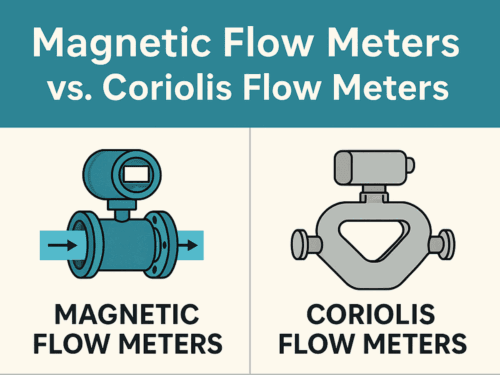When it comes to precision flow measurement in industrial environments, two of the most widely used technologies are Magnetic Flow Meters (Mag Meters) and Coriolis Flow Meters. Both offer high accuracy, reliability, and durability, but they operate on entirely different principles and are suited for different types of fluids and applications.
In this article, we’ll break down how each technology works, examine the advantages and limitations, and provide guidance on where each type of meter tends to perform best. Whether you’re specifying equipment for a new process line or upgrading legacy systems, understanding the key differences can help you make a more informed decision.
How They Work
Magnetic Flow Meters
Magnetic flow meters measure flow based on Faraday’s Law of Electromagnetic Induction, which states that a voltage will be induced when a conductive fluid flows through a magnetic field. Electrodes positioned within the meter body detect the induced voltage, which is proportional to the fluid’s velocity. With a known pipe cross-section, the volumetric flow rate can be calculated.
Importantly, mag meters only work with electrically conductive fluids, typically those with a minimum conductivity of 5 µS/cm.
Coriolis Flow Meters
Coriolis meters operate using the Coriolis effect, a physical phenomenon that occurs when a mass moves within a rotating or vibrating system. In these meters, the fluid flows through one or more vibrating tubes. As the fluid moves, it causes a measurable phase shift in the vibration — a result of the Coriolis force — which correlates directly to the mass flow rate. Additionally, Coriolis meters can measure density and temperature at the same time, making them multifunctional.
Accuracy and Performance
Both mag meters and Coriolis meters are known for their high accuracy, but they excel in different areas.
-
Magnetic flow meters typically offer ±0.25% to ±1.0% accuracy for volumetric flow. Their performance is consistent over a wide range of flow rates and pipe sizes.
-
Coriolis meters can achieve ±0.1% or better mass flow accuracy in ideal conditions, making them one of the most precise flow technologies available today.
However, accuracy in the field is influenced by factors like installation conditions, fluid characteristics, and whether the flow profile is fully developed.
Fluid Compatibility
Mag Meters
Mag meters are suitable for conductive liquids such as:
-
Water and wastewater
-
Slurries
-
Acids and caustics
-
Food-grade fluids with high water content
They do not work with hydrocarbons, gases, or non-conductive fluids like deionized water or oils.
Coriolis Meters
Coriolis meters are much more fluid-agnostic. They can accurately measure:
-
Clean or viscous liquids
-
Gases (though with reduced accuracy)
-
Slurries with low solids content
-
Corrosive chemicals
-
Cryogenic fluids
They are especially valuable in applications requiring mass flow measurement or when fluid density varies.
Installation Considerations
Magnetic Flow Meters
Mag meters are relatively easy to install but do require:
-
A full pipe to avoid flow disturbances
-
Proper grounding
-
Straight runs upstream and downstream (typically 5–10 pipe diameters)
They can be mounted horizontally or vertically, but orientation can affect accuracy depending on whether the pipe remains full.
Coriolis Flow Meters
Coriolis meters are more sensitive to vibration and stress, and their installation should be carefully designed to minimize mechanical interference. They do not require straight pipe runs, making them ideal for space-constrained areas. However, they are generally heavier and bulkier, especially at larger line sizes.
Maintenance and Reliability
Both technologies are highly reliable and have no moving parts, which minimizes maintenance. However:
-
Mag meters may require periodic cleaning if the fluid contains scaling materials or solids that build up on electrodes.
-
Coriolis meters have tightly tuned electronics and sensors that may require recalibration or inspection in high-vibration environments.
Cost and ROI
Generally, Coriolis flow meters are more expensive than mag meters — often significantly so, especially in larger line sizes. However, their ability to simultaneously measure mass flow, density, and temperature can reduce the need for multiple instruments, potentially offsetting the higher upfront cost.
Mag meters are more cost-effective for larger pipes and simple, water-based applications. Their lower purchase price and ease of installation can make them the preferred option in municipal, food, and wastewater industries.
Ideal Applications
| Application Type | Magnetic Flow Meter | Coriolis Flow Meter |
|---|---|---|
| Water and wastewater treatment | ✔️ | ❌ (not economical) |
| Chemical processing | ✔️ | ✔️ |
| Oil & gas (mass flow) | ❌ | ✔️ |
| Food & beverage (clean-in-place) | ✔️ | ✔️ |
| Custody transfer (high accuracy) | ❌ | ✔️ |
| Slurry and pulp | ✔️ (if conductive) | ✔️ (if low solids) |
| Batching and blending systems | ✔️ | ✔️ |
The Differences
Choosing between a magnetic flow meter and a Coriolis flow meter comes down to understanding the fluid properties, measurement requirements, and economic constraints of your specific application.
-
If you’re working with a conductive fluid and require volumetric flow measurement at an affordable cost, a mag meter is likely the better choice.
-
If your application involves non-conductive, viscous, or variable-density fluids — or requires mass flow and density measurement — a Coriolis meter provides unmatched versatility and precision.
Ultimately, both technologies have carved out essential roles in modern flow measurement. Consulting with an experienced instrumentation supplier can help you evaluate total lifecycle cost and performance to ensure the right meter for your process.
Need help deciding which meter is best for your system? Talk to a flow measurement specialist who can assess your application and help you select the best-fit solution — without bias to one technology over another.
